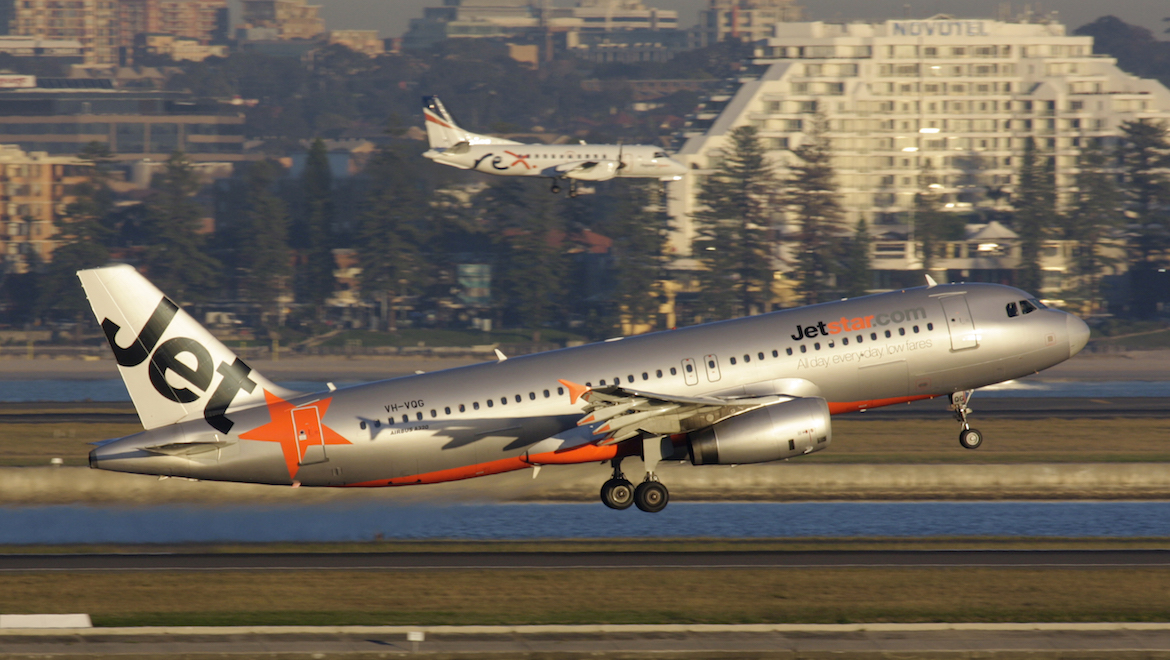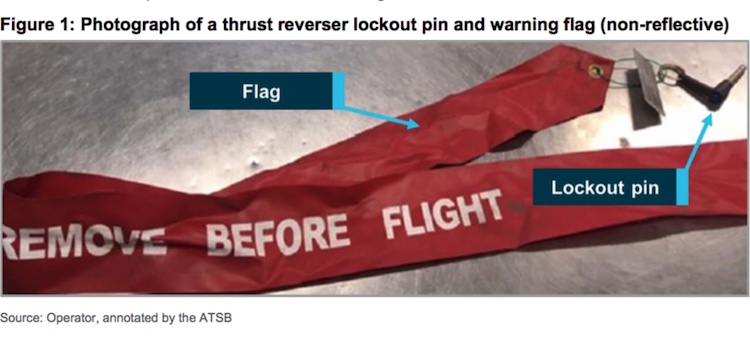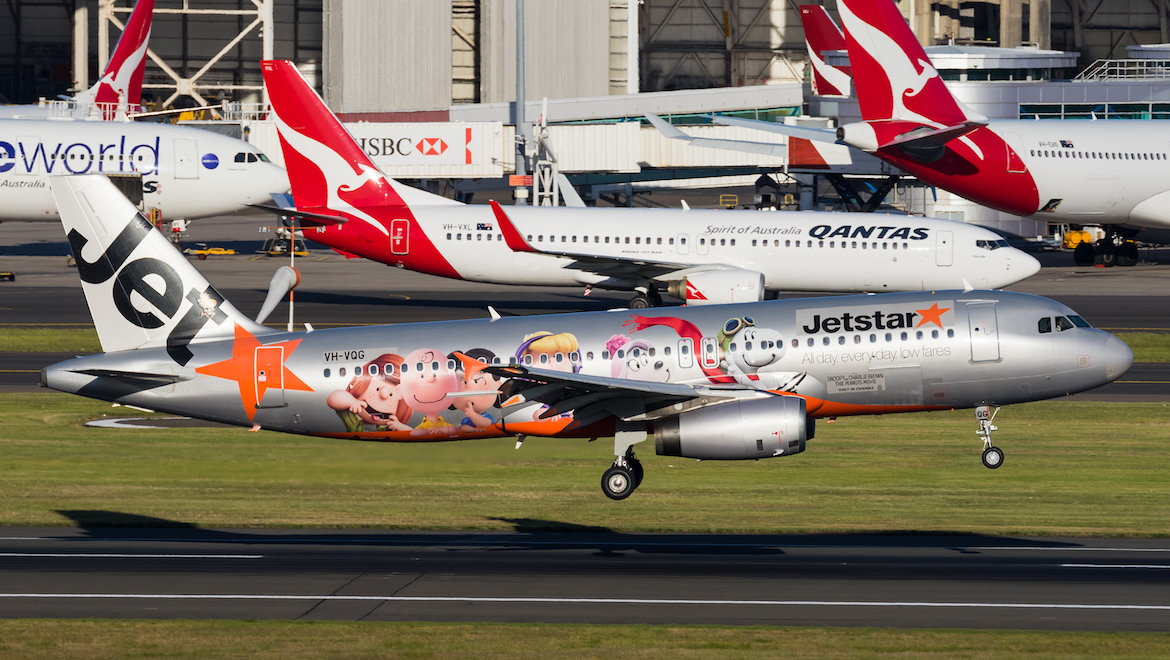
The Australian Transport Safety Bureau (ATSB) has released its final report into a 2017 incident when a Jetstar Airbus A320 was returned to service with one engine’s thrust reverser deactivated because a pin was not removed during overnight maintenance.
The deactivated thrust reverser was discovered on December 18 2017, when the A320 VH-VQG was flying from Adelaide to the Gold Coast with 140 passengers and six crew on board.
Following a normal descent and touchdown, the Captain, and pilot flying, selected both engine thrust reversers.
However, the left engine thrust reverser did not activate and the flight crew received a “reverse fault alert”. The Captain slowed the aircraft with normal braking and the A320 taxied to the gate without further incident.
The ATSB final report into the incident, published on Thursday, said an engineering inspection after the flight found the left engine thrust reverser lockout pin still installed, which had the effect of deactivating the reverser.
The source of the pin was traced back to the evening of December 17 2017, when engine maintenance was carried out ob VH-VQG in Adelaide, the ATSB final report said. Two engineers were assigned to carry out the work.
“At about 2300, after completing their other tasks, the engineers commenced maintenance on VQG,” the ATSB final report said.
“This maintenance was unscheduled and involved investigating an engine bleed air issue. Jetstar had not provided paperwork for this task.”
The ATSB final report said when an engineer went to the tarmac tool store to get a lockout pin – which is used to prevent the inadvertent activation of the thrust reverser – he did not book it out on the store’s computer system.
Further, the standard procedure was to enter the pin’s installation in the aircraft’s technical log. However, the log book was located in the line office, and the engineer decided to record it in the log later.
“A couple of hours later, the engineers completed investigating the bleed air issue,” the ATSB final report said. “By this time, it had started raining.”
“Engineer 1 made a visual inspection around the engine in preparation to close the cowling. The available lighting had reduced as half the tarmac lights automatically turn off at midnight.
“Engineer 1 missed seeing the lockout pin and its 1m long red warning flag, and closed the cowling.”

The ATSB final noted the flag was shorter than those on the pins in the hangar tool store at Adelaide, which had been lengthened to four metres after a previous incident to make them more obvious.
Also, the stand that the engineer had used to install the pin, which may have reminded him about it, had been removed for another task.
“The aircraft maintenance manual thrust reverser de-activation procedure also required the use of specific warning labels in the cockpit, stating that ‘thrust reverser HCU [hydraulic control unit] is de-activated’,” the ATSB final report said. “This procedure was not used during this maintenance task.”
The maintenance work on VH-VQG was completed at about 0230 on December 18. At that time, the two engineers went to complete the paperwork in the office. However, neither entered the installation of the lockout pin in the technical log.
A tooling inventory check also failed to show that the lockout pin was still in the left hand engine as it had not been booked out on the store’s computer.
“Procedures aimed at ensuring the lockout pin’s removal were not followed,” the ATSB final report said.
The ATSB final report noted there had been two previous incidents involving Jetstar A320s which landed with the thrust reversers deactivated because the lockout pins had not been removed during maintenance.
In September 2018, the lockout pins fitted with warning flags were substituted with in-service pins without flags on both engines during maintenance work in Brisbane.
Also, a lockout pin was not booked out on the store’s computer system during maintenance in Adelaide in January 2017, resulting in the right engine thrust reverser not activating when the aircraft landed in Melbourne.
ATSB director for transport safety Stuart Macleod said the incident highlighted the need to consider the environmental conditions in which equipment and tools would potentially be used, as well as the importance of following procedures that, in this incident, would have detected the error.
“When considering the effectiveness of equipment, tooling and procedures that aim to minimise the consequences of an error, an engineered solution is generally more effective than relying on procedural compliance,” Macleod said in a statement.
“Further, within procedural compliance a functional check is generally more effective than a self-check of work.”
The final report said Qantas, as the aircraft maintenance organisation, had taken a number of safety actions in response to this latest incident.
These included “highlighting the importance of the aircraft maintenance manual precautions, and the limitations of human performance on the stages of maintenance, to maintenance staff at Adelaide”.
It had also lengthened all thrust reverser lockout pin flags to hang past the closed cowls, the ATSB final report said. In addition, pins would have a warning notice attached for placement on the engine thrust reverser controls during maintenance.
Qantas has also “focused audits on work practices for tooling and documenting maintenance activities”, as well as reiterated the “responsibilities of engineers to those involved in this incident”, the ATSB final report said.
Further, Airbus had updated its maintenance manual for the type with the inclusion of an operational test of the thrust reverser system to confirm re‑activation after maintenance.
The full report can be found on the ATSB website.













